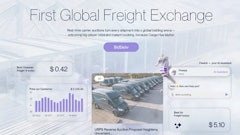
AI is rapidly enhancing the speed and sophistication of cyber threats to the supply chain, including phishing, ransomware and social engineering attacks targeting an organization’s third-party suppliers. While these threats highlight the scary side of AI, this technology can also be used for good, empowering businesses to better monitor, respond to and prevent supply chain risks.
Unfortunately, many aren’t using the tools at their disposal. Cisco’s Cybersecurity Readiness Index revealed that more than 71% of companies across the globe remain in the “Beginner” or “Formative” stages of cybersecurity readiness, meaning they are performing below average in their ability to defend themselves from attacks. Considering this, it’s no wonder cybercrime is estimated to cost a staggering $9.5 trillion this year.
In an increasingly complex global landscape influenced by geopolitical tensions, natural disasters and regulatory pressures, organizations should adopt a proactive risk strategy by integrating AI into their supply chain management.
“Always on” risk monitoring
The speed at which bad actors are unleashing cyberattacks continues to increase as they find new ways to leverage modern tools in their efforts. According to the 2024 Verizon Data Breach Investigation Report, breaches were initiated by exploiting supply chain vulnerabilities at an alarming 180% higher rate in 2023 than the year prior. Supply chain professionals can no longer rely on human eyes alone to identify these gaps or use traditional reactive methods to address breaches after they occur. One of the greatest advantages of AI is its ability to process large quantities of data at a rate well beyond human capabilities.
For example, automated systems for threat detection and response can detect and mitigate cyber threats in real-time, lessening the impact of attacks and conserving time and resources during incident response. Additionally, automation allows for the continuous monitoring and analysis of supplier networks, ensuring that any deviations from normal behavior are quickly detected and resolved.
Supply chains are large and complex, with a multitude of vendors having varying degrees of risk prevention in place. AI identifies even faint signals of risk from each supplier and creates automated incident response plans that uncover issues, provide a recommended course of action specific to the threat at hand and reduce the time needed to overcome the issue while minimizing its potential impact. Whether it's historical breach data, indicators of compromise or threat intelligence feeds, AI algorithms can process robust quantities of information in real-time, creating a stark difference between proactive prevention and catastrophic consequences.
Predictive analytics and enhanced forecasting
That same predictive power for assessing cyber risk can also be used to identify other potential issues in the supply chain, particularly in the face of complex global economies. Is your organization prepared for if/when a labor strike may impact supply chains? Which of your vendors have been mostly heavily impacted by natural disasters? Can you predict how the outcome of the U.S. election may impact your suppliers in Europe or Asia?
Predictive analytics tools provide insights into potential challenges ahead of time and constantly process new data to create recommendations for addressing the unpredictable when it occurs. These analytics can quickly assess how a labor dispute in a shipping yard off the coast of California may impact the supply chain of companies operating in the United Kingdom or Japan. It can identify which products are likely to be held up, provide insights on alternative sources and offer the information organizations need to keep vendors and customers informed.
AI algorithms are also valuable for enhancing supply teams’ forecasting abilities. By using consumer, vendor and other key sources of data, analytics tools can predict fluctuations in availability based on the time of year and provide recommendations. For example, while some organizations may now be in the midst of a mad scramble to identify new sources for key supplies ahead of the holidays, those with quality predictive analytics were likely prepared weeks or even months ago.
Inventory management optimization and streamlined logistics
The capabilities of modern AI tools extend beyond forecasting and predictions to help organizations manage inventory and address logistical challenges. Whether it’s the maintenance of machinery, optimizing routes, managing inventory levels to match demand fluctuations or uncovering opportunities for cost savings, AI algorithms are a major boon to every part of supply chain management. If an event occurs that shuts down a key supplier’s widget factory in Texas, modern tools will quickly identify an alternate factory, assess the routes and timing for getting those widgets to the same locations and process information to ensure it isn’t being done in the most cost-efficient manner.
Unpredictability is an unavoidable component of supply chain management. The economy will ebb and flow, geopolitical strife will impact supply and demand, natural catastrophes will occur, regulations and legislations will change, and so on and so forth. Relying on outdated management methods to prepare for the unpredictable is folly. Modern supply chain management leveraging AI tools and predictive analytics puts any organization in a position to take control of the unknown.



















